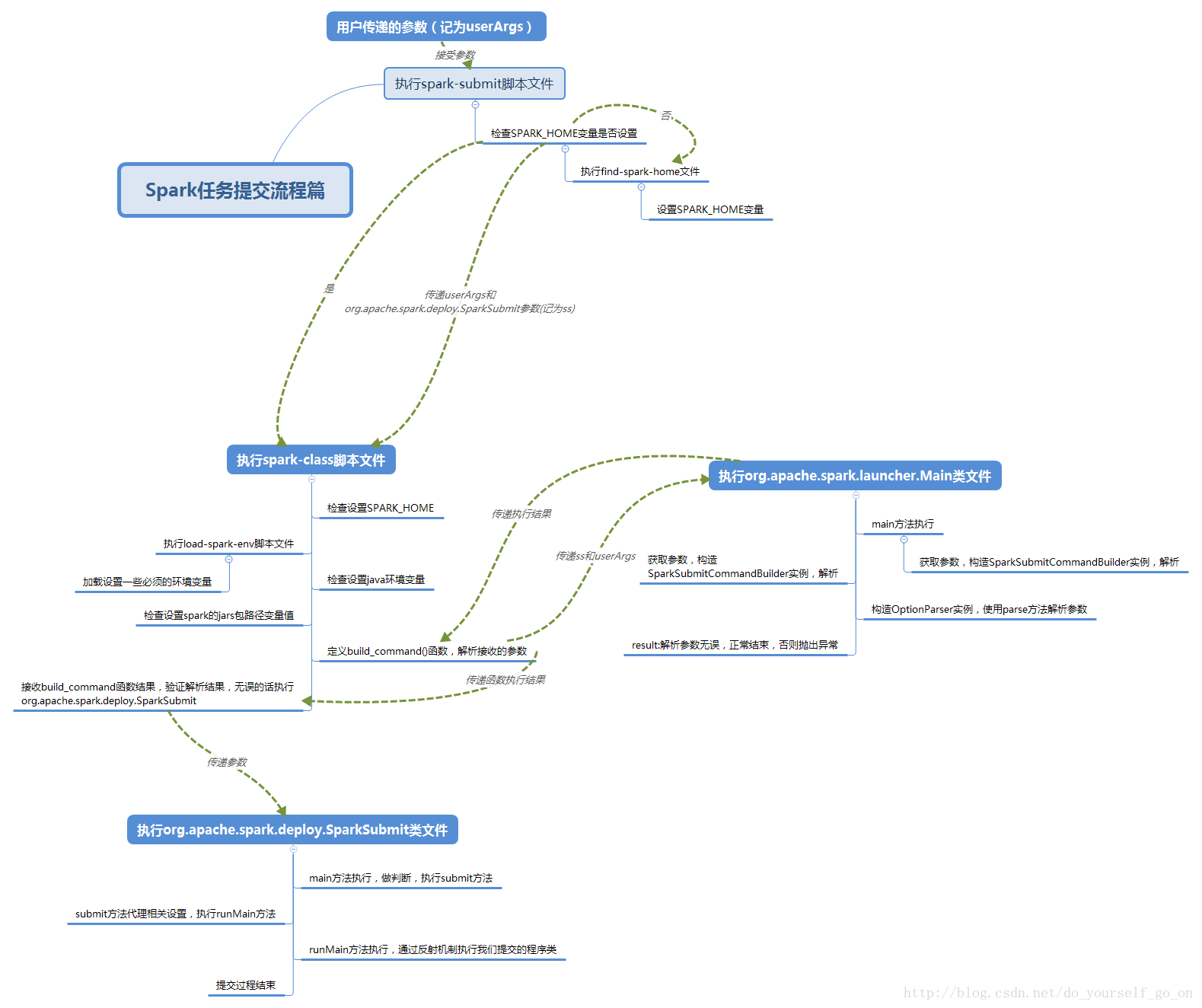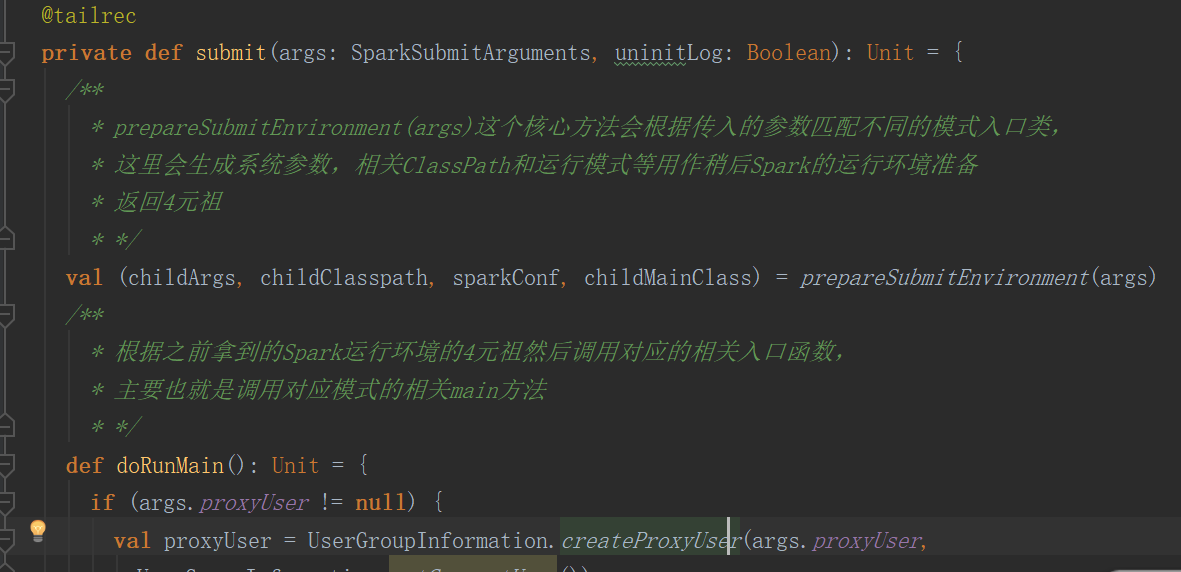一、概述
上一篇主要是介绍了spark启动的一些脚本,这篇主要分析一下Spark源码中提交任务脚本的处理逻辑,从spark-submit一步步深入进去看看任务提交的整体流程,首先看一下整体的流程概要图:
二、源码解读
2.1 spark-submit
# -z是检查后面变量是否为空(空则真) shell可以在双引号之内引用变量,单引号不可 #这一步作用是检查SPARK_HOME变量是否为空,为空则执行then后面程序 #source命令: source filename作用在当前bash环境下读取并执行filename中的命令 #$0代表shell脚本文件本身的文件名,这里即使spark-submit #dirname用于取得脚本文件所在目录 dirname $0取得当前脚本文件所在目录 #$(命令)表示返回该命令的结果 #故整个if语句的含义是:如果SPARK_HOME变量没有设置值,则执行当前目录下的find-spark-home脚本文件,设置SPARK_HOME值 if [ -z "${SPARK_HOME}" ]; then source "$(dirname "$0")"/find-spark-home fi # disable randomized hash for string in Python 3.3+ export PYTHONHASHSEED=0 #执行spark-class脚本,传递参数org.apache.spark.deploy.SparkSubmit 和"$@" #这里$@表示之前spark-submit接收到的全部参数 exec "${SPARK_HOME}"/bin/spark-class org.apache.spark.deploy.SparkSubmit "$@"
所以spark-submit脚本的整体逻辑就是:
首先 检查SPARK_HOME是否设置;if 已经设置 执行spark-class文件 否则加载执行find-spark-home文件
2.2 find-spark-home
#定义一个变量用于后续判断是否存在定义SPARK_HOME的python脚本文件 FIND_SPARK_HOME_PYTHON_SCRIPT="$(cd "$(dirname "$0")"; pwd)/find_spark_home.py" # Short cirtuit if the user already has this set. ##如果SPARK_HOME为不为空值,成功退出程序 if [ ! -z "${SPARK_HOME}" ]; then exit 0 # -f用于判断这个文件是否存在并且是否为常规文件,是的话为真,这里不存在为假,执行下面语句,给SPARK_HOME变量赋值 elif [ ! -f "$FIND_SPARK_HOME_PYTHON_SCRIPT" ]; then # If we are not in the same directory as find_spark_home.py we are not pip installed so we don't # need to search the different Python directories for a Spark installation. # Note only that, if the user has pip installed PySpark but is directly calling pyspark-shell or # spark-submit in another directory we want to use that version of PySpark rather than the # pip installed version of PySpark. export SPARK_HOME="$(cd "$(dirname "$0")"/..; pwd)" else # We are pip installed, use the Python script to resolve a reasonable SPARK_HOME # Default to standard python interpreter unless told otherwise if [[ -z "$PYSPARK_DRIVER_PYTHON" ]]; then PYSPARK_DRIVER_PYTHON="${PYSPARK_PYTHON:-"python"}" fi export SPARK_HOME=$($PYSPARK_DRIVER_PYTHON "$FIND_SPARK_HOME_PYTHON_SCRIPT") fi
可以看到,如果事先用户没有设定SPARK_HOME的值,这里程序也会自动设置并且将其注册为环境变量,供后面程序使用
当SPARK_HOME的值设定完成之后,就会执行Spark-class文件,这也是我们分析的重要部分,源码如下:
2.3 spark-class
#!/usr/bin/env bash #依旧是检查设置SPARK_HOME的值 if [ -z "${SPARK_HOME}" ]; then source "$(dirname "$0")"/find-spark-home fi #执行load-spark-env.sh脚本文件,主要目的在于加载设定一些变量值 #设定spark-env.sh中的变量值到环境变量中,供后续使用 #设定scala版本变量值 . "${SPARK_HOME}"/bin/load-spark-env.sh # Find the java binary #检查设定java环境值 #-n代表检测变量长度是否为0,不为0时候为真 #如果已经安装Java没有设置JAVA_HOME,command -v java返回的值为${JAVA_HOME}/bin/java if [ -n "${JAVA_HOME}" ]; then RUNNER="${JAVA_HOME}/bin/java" else if [ "$(command -v java)" ]; then RUNNER="java" else echo "JAVA_HOME is not set" >&2 exit 1 fi fi # Find Spark jars. #-d检测文件是否为目录,若为目录则为真 #设置一些关联Class文件 if [ -d "${SPARK_HOME}/jars" ]; then SPARK_JARS_DIR="${SPARK_HOME}/jars" else SPARK_JARS_DIR="${SPARK_HOME}/assembly/target/scala-$SPARK_SCALA_VERSION/jars" fi if [ ! -d "$SPARK_JARS_DIR" ] && [ -z "$SPARK_TESTING$SPARK_SQL_TESTING" ]; then echo "Failed to find Spark jars directory ($SPARK_JARS_DIR)." 1>&2 echo "You need to build Spark with the target "package" before running this program." 1>&2 exit 1 else LAUNCH_CLASSPATH="$SPARK_JARS_DIR/*" fi # Add the launcher build dir to the classpath if requested. if [ -n "$SPARK_PREPEND_CLASSES" ]; then LAUNCH_CLASSPATH="${SPARK_HOME}/launcher/target/scala-$SPARK_SCALA_VERSION/classes:$LAUNCH_CLASSPATH" fi # For tests if [[ -n "$SPARK_TESTING" ]]; then unset YARN_CONF_DIR unset HADOOP_CONF_DIR fi # The launcher library will print arguments separated by a NULL character, to allow arguments with # characters that would be otherwise interpreted by the shell. Read that in a while loop, populating # an array that will be used to exec the final command. # # The exit code of the launcher is appended to the output, so the parent shell removes it from the # command array and checks the value to see if the launcher succeeded. #执行类文件org.apache.spark.launcher.Main,返回解析后的参数 build_command() { "$RUNNER" -Xmx128m -cp "$LAUNCH_CLASSPATH" org.apache.spark.launcher.Main "$@" printf "%d�" $? } # Turn off posix mode since it does not allow process substitution #将build_command方法解析后的参数赋给CMD set +o posix CMD=() while IFS= read -d '' -r ARG; do CMD+=("$ARG") done < <(build_command "$@") COUNT=${#CMD[@]} LAST=$((COUNT - 1)) LAUNCHER_EXIT_CODE=${CMD[$LAST]} # Certain JVM failures result in errors being printed to stdout (instead of stderr), which causes # the code that parses the output of the launcher to get confused. In those cases, check if the # exit code is an integer, and if it's not, handle it as a special error case. if ! [[ $LAUNCHER_EXIT_CODE =~ ^[0-9]+$ ]]; then echo "${CMD[@]}" | head -n-1 1>&2 exit 1 fi if [ $LAUNCHER_EXIT_CODE != 0 ]; then exit $LAUNCHER_EXIT_CODE fi CMD=("${CMD[@]:0:$LAST}") #执行CMD中的某个参数类org.apache.spark.deploy.SparkSubmit exec "${CMD[@]}"
spark-class文件的执行逻辑稍显复杂,总体上应该是这样的:
检查SPARK_HOME的值----》执行load-spark-env.sh文件,设定一些需要用到的环境变量,如scala环境值,这其中也加载了spark-env.sh文件-------》检查设定java的执行路径变量值-------》寻找spark jars,设定一些引用相关类的位置变量------》执行类文件org.apache.spark.launcher.Main,返回解析后的参数给CMD-------》判断解析参数是否正确(代表了用户设置的参数是否正确)--------》正确的话执行org.apache.spark.deploy.SparkSubmit这个类
2.4 SparkSubmit
2.1最后提交语句,D:srcspark-2.3.0coresrcmainscalaorgapachesparkdeploySparkSubmit.scala
exec "${SPARK_HOME}"/bin/spark-class org.apache.spark.deploy.SparkSubmit "$@"
override def main(args: Array[String]): Unit = { // Initialize logging if it hasn't been done yet. Keep track of whether logging needs to // be reset before the application starts. val uninitLog = initializeLogIfNecessary(true, silent = true) //拿到submit脚本传入的参数 val appArgs = new SparkSubmitArguments(args) if (appArgs.verbose) { // scalastyle:off println printStream.println(appArgs) // scalastyle:on println } //根据传入的参数匹配对应的执行方法 appArgs.action match { //根据传入的参数提交命令 case SparkSubmitAction.SUBMIT => submit(appArgs, uninitLog) //只有standalone和mesos集群模式才触发 case SparkSubmitAction.KILL => kill(appArgs) //只有standalone和mesos集群模式才触发 case SparkSubmitAction.REQUEST_STATUS => requestStatus(appArgs) } }
2.4.1 submit十分关键,主要分为两步骤
(1)调用prepareSubmitEnvironment
(2)调用doRunMain
